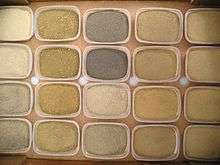Soil type

In terms of soil texture, soil type usually refers to the different sizes of mineral particles in a particular sample. Soil is made up in part of finely ground rock particles, grouped according to size as sand and silt in addition to clay, organic material such as decomposed plant matter.
Each component, and their size, play an important role. For example, the large particles, sand, determine aeration and drainage characteristics, while the tiniest, sub-microscopic clay particles, are chemically active, binding with water and plant nutrients. The ratio of these sizes determines soil type: clay, loam, clay-loam, silt-loam, and so on.
In addition to the mineral composition of soil, humus (organic material) also plays an important role in soil characteristics and fertility for plant life. Soil may be mixed with larger aggregate, such as pebbles or gravel. Not all types of soil are permeable, such as pure clay.
There are many recognized soil classifications, both international and national.
See also
- Category:Types of soil
External links
- Soil classification systems
- A Compendium of On-Line Soil Survey Information Soil Classification for Soil Survey
- OSHA Soil Classification - 1926 Subpart P App A
- soil types
